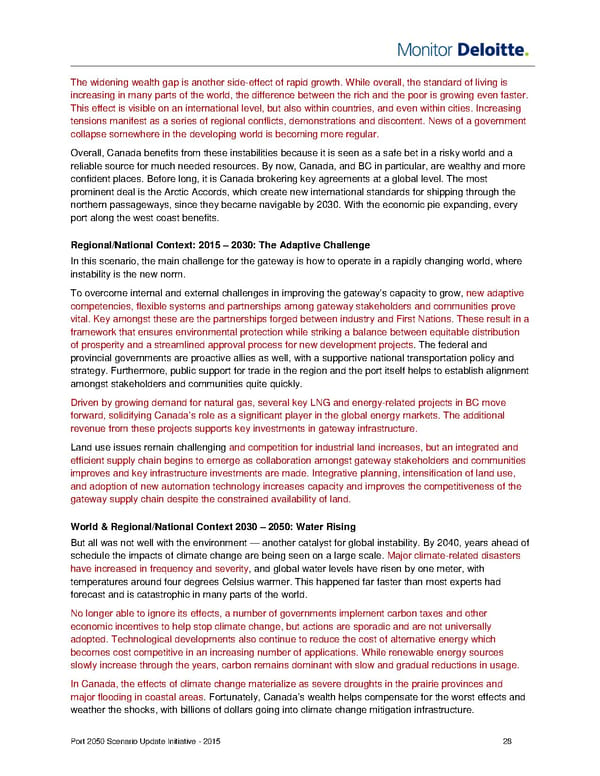The widening wealth gap is another side-effect of rapid growth. While overall, the standard of living is increasing in many parts of the world, the difference between the rich and the poor is growing even faster. This effect is visible on an international level, but also within countries, and even within cities. Increasing tensions manifest as a series of regional conflicts, demonstrations and discontent. News of a government collapse somewhere in the developing world is becoming more regular. Overall, Canada benefits from these instabilities because it is seen as a safe bet in a risky world and a reliable source for much needed resources. By now, Canada, and BC in particular, are wealthy and more confident places. Before long, it is Canada brokering key agreements at a global level. The most prominent deal is the Arctic Accords, which create new international standards for shipping through the northern passageways, since they became navigable by 2030. With the economic pie expanding, every port along the west coast benefits. Regional/National Context: 2015 – 2030: The Adaptive Challenge In this scenario, the main challenge for the gateway is how to operate in a rapidly changing world, where instability is the new norm. new adaptive To overcome internal and external challenges in improving the gateway’s capacity to grow, competencies, flexible systems and partnerships among gateway stakeholders and communities prove vital. Key amongst these are the partnerships forged between industry and First Nations. These result in a framework that ensures environmental protection while striking a balance between equitable distribution of prosperity and a streamlined approval process for new development projects. The federal and provincial governments are proactive allies as well, with a supportive national transportation policy and strategy. Furthermore, public support for trade in the region and the port itself helps to establish alignment amongst stakeholders and communities quite quickly. Driven by growing demand for natural gas, several key LNG and energy-related projects in BC move forward, solidifying Canada’s role as a significant player in the global energy markets. The additional revenue from these projects supports key investments in gateway infrastructure. Land use issues remain challenging and competition for industrial land increases, but an integrated and efficient supply chain begins to emerge as collaboration amongst gateway stakeholders and communities improves and key infrastructure investments are made. Integrative planning, intensification of land use, and adoption of new automation technology increases capacity and improves the competitiveness of the gateway supply chain despite the constrained availability of land. World & Regional/National Context 2030 – 2050: Water Rising But all was not well with the environment — another catalyst for global instability. By 2040, years ahead of schedule the impacts of climate change are being seen on a large scale. Major climate-related disasters have increased in frequency and severity, and global water levels have risen by one meter, with temperatures around four degrees Celsius warmer. This happened far faster than most experts had forecast and is catastrophic in many parts of the world. No longer able to ignore its effects, a number of governments implement carbon taxes and other economic incentives to help stop climate change, but actions are sporadic and are not universally adopted. Technological developments also continue to reduce the cost of alternative energy which becomes cost competitive in an increasing number of applications. While renewable energy sources slowly increase through the years, carbon remains dominant with slow and gradual reductions in usage. In Canada, the effects of climate change materialize as severe droughts in the prairie provinces and major flooding in coastal areas. Fortunately, Canada’s wealth helps compensate for the worst effects and weather the shocks, with billions of dollars going into climate change mitigation infrastructure. Port 2050 Scenario Update Initiative - 2015 28
 Monitor Deloitte - Final Report Page 29 Page 31
Monitor Deloitte - Final Report Page 29 Page 31